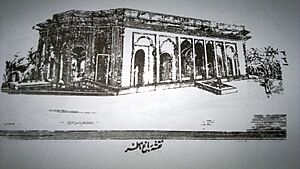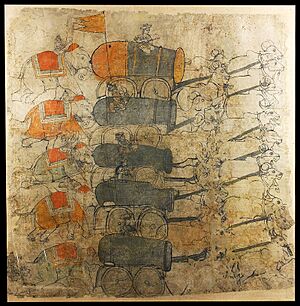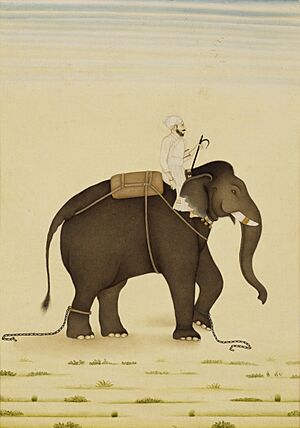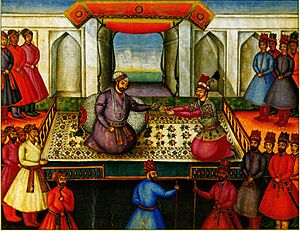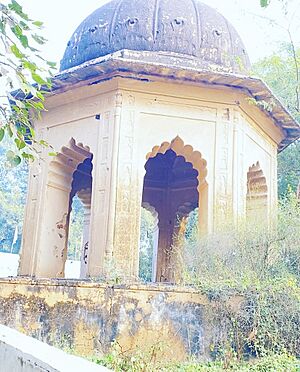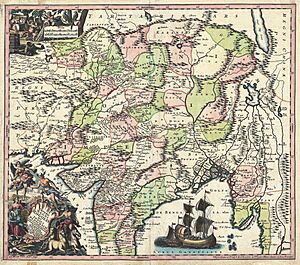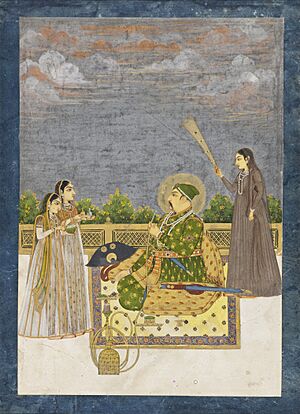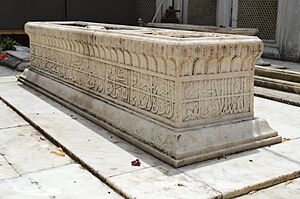Muhammad Shah facts for kids
Quick facts for kids Muhammad Shah |
|||||||||
|---|---|---|---|---|---|---|---|---|---|
| Padishah Al-Sultan Al-Azam |
|||||||||
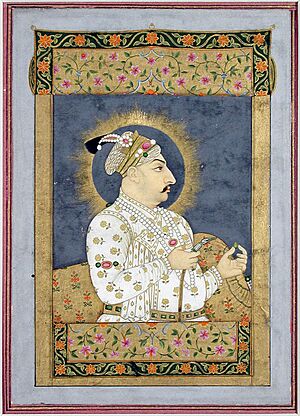
Emperor Muhammad Shah holding an emerald and a mouthpiece of a huqqa, by Nidha Mal, c. 1730
|
|||||||||
| 13th Mughal Emperor | |||||||||
| Reign | 27 September 1719 – 26 April 1748 | ||||||||
| Coronation | 29 September 1719 | ||||||||
| Predecessor | Shah Jahan II Jahangir II (titular) |
||||||||
| Successor | Ahmad Shah Bahadur | ||||||||
| Wazirs |
|
||||||||
| Born | Roshan Akhtar 7 August 1702 Ghazni, Kabul Subah, Mughal Empire |
||||||||
| Died | 26 April 1748 (aged 45) Delhi, Mughal Empire |
||||||||
| Burial | Mausoleum of Muhammad Shah, Nizamuddin Dargah, Delhi, India | ||||||||
| Consort |
Badshah Begum
(m. 1721) |
||||||||
| Wives |
|
||||||||
| Issue |
|
||||||||
|
|||||||||
| House | House of Babur | ||||||||
| Dynasty | Timurid dynasty | ||||||||
| Father | Jahan Shah | ||||||||
| Mother | Fakhr-un-Nissa Begum | ||||||||
| Religion | Sunni Islam (Hanafi) | ||||||||
Muhammad Shah (born Roshan Akhtar; 7 August 1702 – 26 April 1748) was the thirteenth Mughal Emperor. He ruled from 1719 to 1748. He was the son of Khujista Akhtar, who was the fourth son of Bahadur Shah I.
Muhammad Shah became emperor at just 16 years old. He was chosen by two powerful nobles, the Sayyid Brothers. They kept a close eye on him at first. Later, Muhammad Shah managed to remove the Sayyid Brothers from power. He did this with the help of Nizam-ul-Mulk, Asaf Jah I. One Sayyid brother, Syed Hussain Ali Khan, was killed in 1720. The other, Sayyid Hassan Ali Khan, was captured and later died in 1722.
Muhammad Shah loved the arts, especially music and culture. He was also known for supporting new administrative ideas. His special pen-name was "Sadrang." Some people called him "Bahadur Shah Rangila," which means "the colorful" or "the joyful," after his grandfather, Bahadur Shah I.
However, Muhammad Shah's rule saw a quick decline of the Mughal Empire. This decline became much worse after Nader Shah's invasion of India in 1739. During this invasion, the city of Delhi was attacked and looted. This event shocked everyone, including the British.
Contents
Early Reign and Challenges
Removing the Sayyid Brothers

On October 9, 1720, Syed Hussain Ali Khan Barha, a top commander of the Mughal army, was killed. Muhammad Shah then took direct control of the army.
After this, Nizam-ul-Mulk, Asaf Jah I was sent to take full control of six Mughal areas in the Deccan. Another important leader, Muhammad Amin Khan Turani, was sent to find the other Sayyid brother, Syed Hassan Ali Khan Barha. Hassan Khan Barha was defeated in a battle in November 1720 and died two years later. The fall of the Sayyid Brothers meant the Mughal Empire started losing its strong hold over the Deccan region.
Losing Control of Deccan Regions
In February 1722, Muhammad Shah made Asaf Jah I his Grand Vizier (a chief minister). Asaf Jah I wanted to expand his own power in the Deccan. He eventually lost the emperor's trust. Asaf Jah I then resigned and went back to the Deccan.
In 1723, Asaf Jah I went on a trip to the Deccan. There, he fought Mubariz Khan, who was the Mughal governor of the Deccan. Mubariz Khan had been keeping the Maratha Empire from causing too much trouble. Asaf Jah I defeated Mubariz Khan in the Battle of Shakar Kheda. After this victory, Asaf Jah I created his own state, the Hyderabad State, and became its ruler, known as the Nizam of Hyderabad, in 1725.
The Mughal-Maratha Wars (1728–1763) caused a lot of damage to six important Mughal regions in the Deccan. Asaf Jah I even encouraged the Marathas to attack northern Mughal lands. This was to protect his new independence.
Muhammad Shah then appointed Qamar-ud-Din Khan as Grand Wazir. However, he was soon replaced by Roshan-ud-Daulah Turrah Baz Khan. This was done to reduce the power of the Turani family.
Even though the Deccan regions were lost in 1724, some leaders remained loyal. The Nawab of Awadh Saadat Ali Khan and the Mughal governor Dilawar Khan stayed loyal to the emperor. They created a strong base on the Malabar Coast.
Cultural Growth

The Urdu language was already used before Muhammad Shah's rule. But during his time, it became much more popular. He made it the official court language, replacing Persian.
During Muhammad Shah's reign, Qawwali music was brought back to the Mughal court. It quickly became popular across South Asia. Muhammad Shah also started religious schools called Maktabs. For the first time, the Quran was translated into simple Persian and Urdu during his rule.
The traditional Turkic clothing worn by Mughal nobles was replaced by the Sherwani. Muhammad Shah also liked to wear clothes influenced by the Deccan region.
Muhammad Shah loved the performing arts. He supported many artists, even if it meant less focus on running the empire. Artists like Nidha Mal and Chitarman created lively paintings. These showed scenes of court life, like Holi celebrations and hunting. The court also had famous musicians like Naimat Khan (Sadarang) and his nephew Firoz Khan (Adarang). Their music helped make the khyal style of Indian classical music very popular.
Muhammad Shah himself was a poet, using the pen-name "Sadrang." He also composed classical raga songs. These songs were about love and the festival of Holi.
Scientific Progress
During Muhammad Shah's reign, an important scientific book was created. It was called the Zij-i Muhammad Shahi. Jai Singh II of Amber completed this 400-page work between 1727 and 1735.
Regional Challenges
In the Punjab region, the Sikhs were fighting against the local Mughal governors. They used quick attacks to cause a lot of trouble.
Losing Gujarat and Malwa
After defeating Asaf Jah in February 1728, Bajirao I and his brother Chimaji Appa attacked Malwa again. The Mughal governor Giridhar Bahadur was defeated and killed in November 1729.
In 1731, Asaf Jah convinced some Maratha leaders to switch sides and join Emperor Muhammad Shah. However, these leaders were defeated by a large Maratha army led by Bajirao I. Bajirao I then attacked Gujarat and took control of it by 1735.
Bajirao I defeated a trained Mughal army. But he had to retreat when more Mughal soldiers arrived near Delhi. Bajirao then made peace with Emperor Muhammad Shah. As part of the agreement, Malwa was given to the Marathas.
Nader Shah's Invasion
Invasion of the Mughal Empire
In May 1738, Nader Shah attacked northern Afghanistan and captured Ghazni. He took Kabul in June and Jalalabad in September. By November, he had crossed the Khyber Pass and attacked the fortress of Peshawar. In January 1739, he captured Lahore. He defeated the Mughal governor Zakariya Khan Bahadur and his 25,000 soldiers near the Chenab river.
Nader Shah's forces then met groups of Sikh rebels. Nader Shah believed these rebels would benefit from his invasion. His army took control of land all the way to Attock. This made Muhammad Shah and his court realize that Nader Shah wanted more than just to loot one region. Cities like Wazirabad, Eminabad, and Gujrat were not only looted but also destroyed. Near Larkana, Nader Shah's forces completely defeated the Mughal army of the Nawab of Sindh, Main Noor Mohammad Kalhoro. They captured him and his two sons. Sirhind was then captured in February 1739, opening the way to Delhi, the Mughal capital.
Battle of Karnal
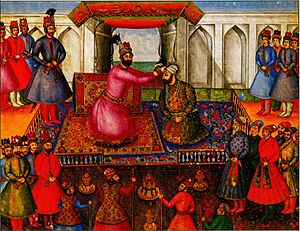
Rao Bal Kishan of Rewari tried to defend Delhi with his army. He fought bravely but was killed in battle. Nader Shah was very impressed by him. He told Emperor Muhammad Shah that if all their forces had helped Rao Bal Kishan, he might not have been able to enter Delhi. Muhammad Shah ordered a special monument, a royal chhatri, to honor Rao Bal Kishan.
After entering Delhi, Nader Shah said his invasion was for religious reasons. He claimed he would send his army to stop the "wretched Marathas" if they moved towards Delhi.
Looting of Delhi

At first, Nader Shah's stay in Delhi was peaceful. However, rumors spread that he had been killed. People in the city attacked the Persian soldiers, killing some of them. Nader Shah became very angry and ordered his army to kill the people of Delhi. At least 30,000 people died.
Muhammad Shah and Asaf Jah I had to beg Nader Shah to stop the killing. He agreed and then began to loot the Mughal treasury. Famous treasures like the Peacock Throne, the Daria-i-Noor diamond, and the Koh-i-Noor diamond were taken. Huge amounts of wealth, along with elephants and horses, were also seized. Muhammad Shah also had to give his daughter, Jahan Afruz Banu Begum, to Nader Shah's youngest son as a bride.
After this, Asaf Jah I returned to the Deccan. He made his eldest son, Intizam-ud-Daula, a major commander in the Mughal Army.
Later Maratha Conflicts
In 1740, Dost Ali Khan, the Nawab of the Carnatic, and Chanda Sahib had to fight against the Marathas. The Marathas were led by Raghoji I Bhonsle. Dost Ali Khan was killed in battle in May 1740 while defending Arcot, which was then looted. Chanda Sahib and his soldiers were captured and imprisoned.
Chanda Sahib and his forces bravely defended their lands during the Siege of Trichinopoly (1741). Even though they were greatly outnumbered by the Marathas, their efforts caught the attention of Joseph François Dupleix, an official from the French East India Company.
Asaf Jah I was not happy about the Marathas taking over the Carnatic region. He led an army to free the area. He was joined by Sadatullah Khan II and Anwaruddin Muhammed Khan. Together, they recaptured Arcot and started the Siege of Trichinopoly (1743). This siege lasted five months. It forced the Marathas, led by Murari Rao Ghorpade, to leave the Carnatic.
In 1747, the Marathas, led by Raghoji I Bhonsle, began to raid and take over lands belonging to Nawab of Bengal Alivardi Khan. During a Maratha invasion of Orissa, the governor Mir Jafar pulled back his forces. But when Alivardi Khan and the Mughal Army arrived, they completely defeated Raghoji I Bhonsle and his Maratha forces at the Battle of Burdwan. The angry Nawab of Bengal, Alivardi Khan, then fired Mir Jafar. However, four years later, Emperor Muhammad Shah gave Orissa to the Marathas.
Foreign Relations
After Nader Shah's invasion, the Ottoman Empire took advantage of the weakened Mughal Empire. During this time, Emperor Muhammad Shah tried to regain lost territory. However, he was then attacked by the Durrani Empire at the Battle of Manupur (1748).
Marriages and Family
Emperor Muhammad Shah had four wives. His first wife and main queen was his cousin, Princess Badshah Begum. She was the daughter of Emperor Farrukhsiyar. They married on December 8, 1721, in Delhi. He gave her the title Malika-uz-Zamani, meaning "Queen of the Age." They had a son, Shahriyar Shah Bahadur, who died young in 1726. Badshah Begum passed away in 1789.
Muhammad Shah's second wife was Sahiba Mahal. They had a daughter named Hazrat Begum, who later married Ahmad Shah Durrani in 1757.
His third wife was a dancing girl named Udham Bai. She gave birth to his successor, Ahmad Shah Bahadur, on December 23, 1725. After his birth, Ahmad Shah was raised by Badshah Begum, who loved him like her own son. Because of Badshah Begum's efforts, Ahmad Shah was able to become emperor after Muhammad Shah's death in 1748.
Death
The Mughal Army won the Battle of Manupur (1748), but it came at a high cost. Many soldiers died. This news was kept secret at first. However, when Emperor Muhammad Shah found out, he became very ill and could not speak. He stayed in his rooms for three days and fasted. His guards heard him crying and saying, "How could I find anyone as loyal as he?" (referring to Qamaruddin Khan, who died in battle).
Muhammad Shah died from grief on April 26, 1748. Imams (religious leaders) from Mecca attended his funeral. Muhammad Shah's tomb is located in the Nizamuddin Dargah complex in Delhi.
Images for kids
-
A silver coin minted during the reign of the Mughal Emperor Muhammad Shah from Bombay.
-
French-issued rupee in the name of Muhammad Shah (1719-1748) for Northern India trade, cast in Pondichéry.
See Also
- Battle of Karnal
- Koh-i-Noor
- Peacock Throne
- Battles involving the Mughal Empire
- Ahirwal
- Rewari



